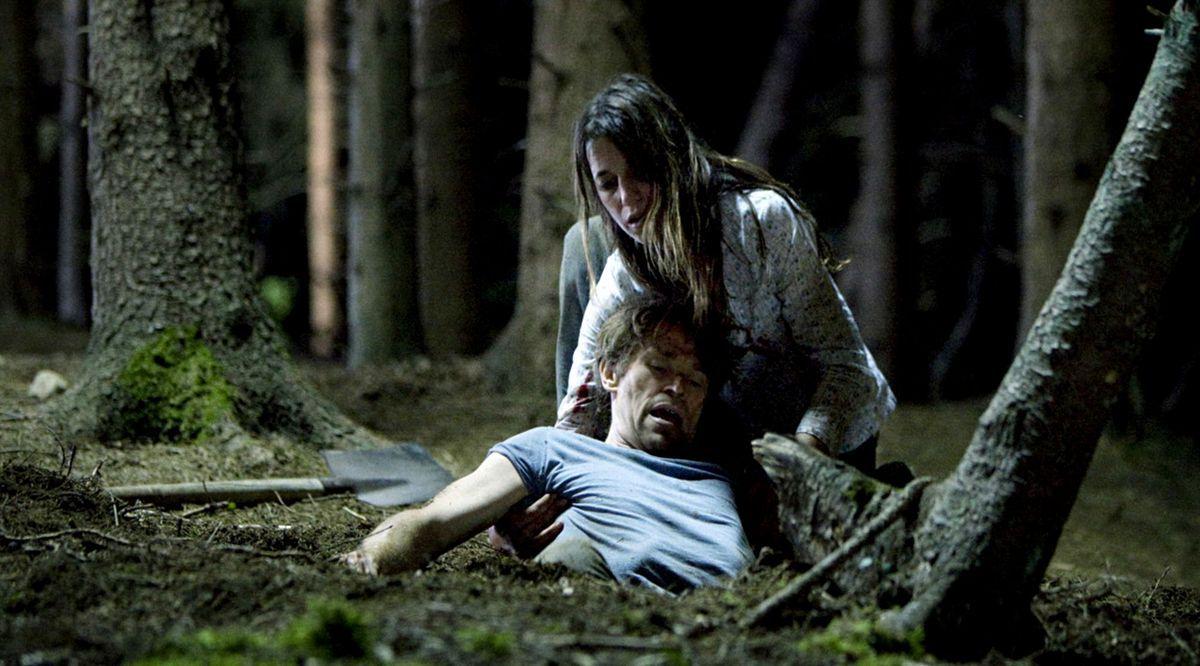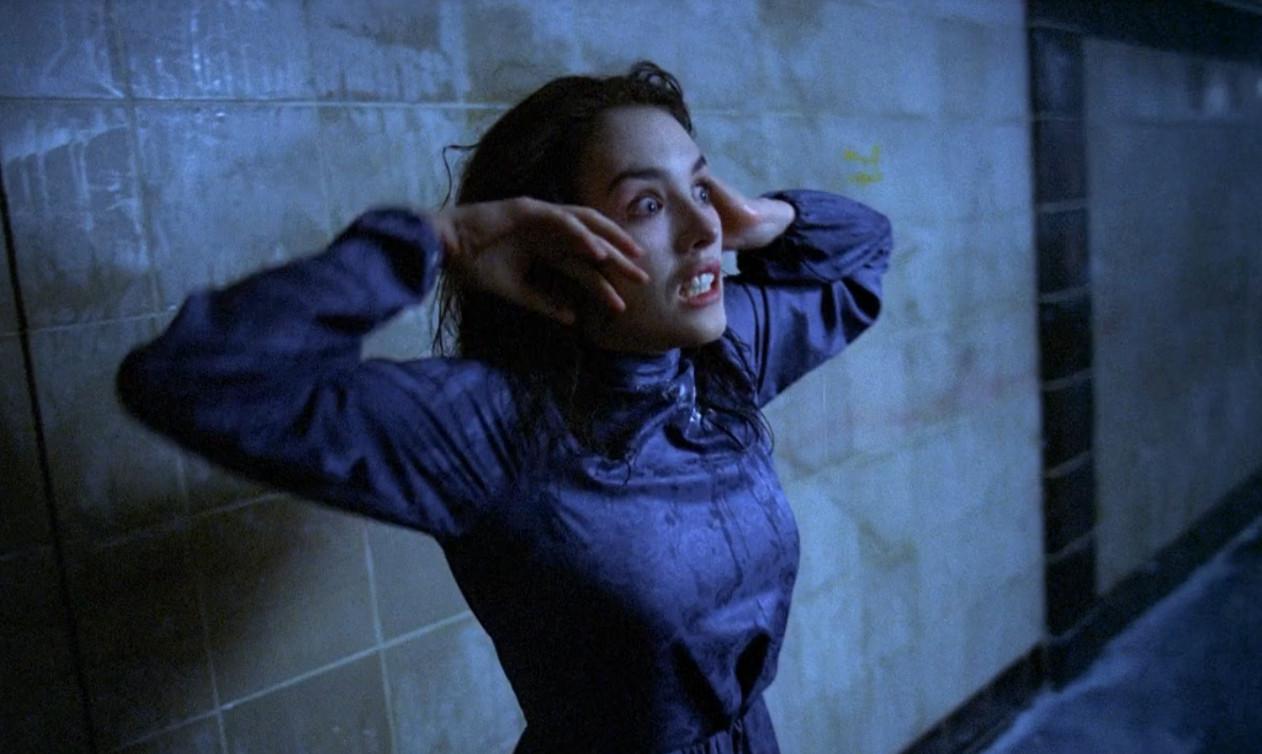“Two Thumbs Down” blared the print ads for Lost Highway—a brilliant example of pull-quote jiu-jitsu designed to give David Lynch’s characteristically inexplicable thriller a bit of leverage. By leaning into the negative assessment being levied by arguably the only truly taste-making critics around (and in the context of Roger Ebert, whose thumb loomed larger than Gene Siskel’s, having also slammed Blue Velvet and Wild at Heart), Lost Highway’s poster signified defiance. Its joke was self-deprecating but also slyly weaponized against an impending consensus that the director’s cult-like fans—and, potentially, scores of other adventurous, antiestablishment-minded potential audience members—would see as the enemy. In response to Siskel and Ebert’s downward digits, Lynch’s marketing team crafted the semiotic equivalent of a middle finger.
I thought of the Lost Highway poster when I saw the new online trailer for Mother!, a film that has already staked its claim as the most critically divisive title of 2017, with director Darren Aronofsky alternately hailed as a Lynch-like genius bringing difficult, personal art into the multiplex and derided as an undisciplined hack blowing studio money on a movie that’s subsequently been empirically proved to have zero appeal. Given the media frenzy over its polarizing festival bows in Venice and Toronto and dead-in-the-water box office—the latter an embarrassment being laid at the (shoeless) feet of star Jennifer Lawrence—it’s understandable that Paramount would want to try to shanghai the narrative around its new, high-profile film maudit and reframe it as love-it-or-hate-it conversation piece. And there is no doubt that people are talking: including and especially Aronofsky, whose interviews in Vulture and The New York Times scan as the gestures of a proud but insecure auteur desperate to explain himself before it’s too late.
In this, Aronofsky could not be more different than Lynch, whose steadfast, long-standing refusal to delve too deeply into his works’ meanings has gone a long way toward entrenching him as America’s leading pop surrealist. Of all the analyses swirling online about the ending of Twin Peaks: The Return, the ones I’ve enjoyed the most have all pointed out that the name of the supreme negative force in the show’s universe, “Jiāo dāi”—or “Judy”—derives from a Mandarin word meaning to “explain”; the worst, most evil thing that David Lynch can imagine is a mystery with a definitive solution. But Aronofsky is all too happy to address his own film’s smoldering pileup of mixed metaphors, biblical symbolism, climate-change paranoia, and even the reasons for its exclamation-pointed title (although his detailed recollection of typing it out for the first time can’t compete with this tweet).
For me, the most interesting thing about Mother! is not what its creator—or, I guess, given how he’s now explicitly instructed us to read it as a hallucinatory rendering of the Book of Genesis, its Creator—thinks it’s about as its attempt to fit into a particular tradition of cinematic provocation: the semi-mainstream outrage machine, a work carefully calibrated to simultaneously attract and repulse a wide audience. For example, to stick for a minute with David Lynch, Eraserhead, shot in industrial neighborhoods in Philadelphia over a period of several years on a shoestring budget with unknown actors and barely released into theaters in 1977, does not qualify: Its notoriety as perhaps the key American cult movie of the 20th century developed organically. But Wild at Heart, which took a legit It Boy and Girl duo (Nicolas Cage and Laura Dern) and inserted them into an outrageous, obscene, deliberately transgressive extended parody of The Wizard of Oz—and ended up winning the Palme d’Or at the Cannes Film Festival—absolutely does.
Aronofsky’s film’s case hinges on the participation of its above-the-title talent, especially Lawrence, who is one of a handful of genuine movie stars standing astride the Hollywood landscape. While I have a hard time buying (or stomaching) Aronofsky’s comparison of his own work to that of the great Luis Buñuel—specifically, as a variation on The Exterminating Angel (1962), with the original’s room full of existentially trapped partygoers switched out for a house party whose revelers can’t take a hint to leave—it’s true that Buñuel was an early adopter of the strategy of using conspicuously glamorous actresses as bait for works with can-of-worms qualities. The use of chic, flawless Catherine Deneuve as a housewife-turned-call-girl in the brilliant Belle de Jour ranks as one of the great casting coups of the 1960s, right alongside the actress’s even more daring deployment by Roman Polanski in Repulsion—a movie whose evocation of housebound paranoia is also plundered by Mother! (especially in a shot where Lawrence screams as an arm smashes through a wall beside her).
The modern master of these tactics is Lars von Trier, whose M.O. since the beginning of the 2000s has been to generate publicity—and controversy—by sticking extremely famous women in movies designed as Catherine wheels: The Dane likes to break his characters, and occasionally the actresses playing them. Von Trier feuded with Björk on the set of Dancer in the Dark, a film in which the singer’s character slowly goes blind, bludgeons a neighbor to death with a steel lock box, is arrested for murder, and hung by her neck until she’s dead: The absurd intensity of the spectacle is heightened both by Björk’s extra-textual presence as a pop star and the audience’s media-fueled knowledge that she was just about as miserable in real life as her onscreen alter ego. In 2003, Von Trier coerced Nicole Kidman, fresh off her stunt-casting expedition with husband Tom Cruise in Stanley Kubrick’s valedictory Eyes Wide Shut, to get put through the ringer in Dogville, a Depression-era fable whose heroine, Grace (Kidman), is violently scapegoated for the sins of a small mountain town. Kidman’s performance is among her best, but the experience took its toll—she tapped out of appearing in the sequel, Manderlay.
But the von Trier movie I really thought of during Mother!—more than once and never once to the newer movie’s advantage—was Antichrist, starring Willem Dafoe and Charlotte Gainsbourg as a married couple who’ve retreated to the woods to work through their grief over the death of their infant son. The two films superficially have plenty in common: isolated rural locations; characters who don’t have proper names (Dafoe and Gainsbourg are billed as “He” and “She”); the taboo image of dead babies; overt references to both scripture and pagan mythology (“She” is working on a thesis about the historical persecution of female witches during the trip); agile, stomach-turning camera work; and whispers of veiled autobiography around the edges of the frame. The one thing that Aronofsky won’t officially cop to is that Mother! is a riff on his called-off engagement to Rachel Weisz—which would make Javier Bardem’s charming, arrogant, demonic poet a directorial stand-in. But von Trier, whose interviews are historically candid, to the point of getting him banned from film festivals, spoke openly about how Antichrist was inspired by, and representative of, his own depression—and also how Gainsbourg’s character, rather than Dafoe’s, was his true analogue in the story.

This has always been the question with von Trier: If his brilliantly engineered films’ seeming, abject misogyny is an expression of artistic cruelty or an attempt at empathy. In Antichrist, Gainsbourg’s “She” endures about as much pain and humiliation as any character in contemporary cinema before throwing it back at her husband, who, as usual for von Trier, is the piece’s true villain—a caricature of rational, controlling, condescending masculinity (he literally tries to hypnotize his wife’s sadness away and grows uncomfortable whenever she gives voice to her feelings). Where the ostensible critique of male vanity in Mother! hinges on Lawrence’s character being reduced, in the final equation, to a helpless, bruised muse—a vessel fated to be re-created, over and over again, with no say in the matter—Antichrist lets “She” dominate the action.
Von Trier’s eye for horrific, poetic imagery is considerably sharper than Aronofsky’s, and so is his sense of humor. The attempts at levity in Mother! are broad and obvious, bound up in the expert performances of Ed Harris and Michelle Pfeiffer as married interlopers whose inappropriateness catalyzes the endless home invasion that takes up most of the film’s running time; they’re the comic relief. In Antichrist, the lack of relief, of any kind, is the comedy. The sheer endurance-test nature of the material takes on its own satirical velocity without undermining the seriousness of the violence, which is graphic in a way that Mother!, with its MPAA R-rating, can’t approach. Nor does it dull the power of the script’s various subtexts, which are nightmarishly contradictory where Aronofsky’s are, finally, far too cute to be unsettling. Mother! solves itself, but Antichrist remains wide open, like a wound.

But if you really want to see an art-horror movie that eats Aronofsky’s film’s lunch—and was seemingly as much an influence on von Trier as von Trier was on Aronofsky—the title to seek out is the late Polish director Andrzej Zulawski’s Possession. It’s a worthy contender for the title of the strangest, most disturbing genre film ever made. Its designated audience lure is Isabelle Adjani, the French actress who in the 1970s gained international fame for roles in European hits like The Story of Adele H. and Hollywood productions like The Driver. She was 25 when Zulawski cast her in Possession as Anna, a woman in the midst of separating from her husband, Mark (Sam Neill); he suspects that she’s having an affair and tails her through Berlin, eventually discovering that she is indeed sleeping with somebody else—but not somebody human.
Trying to synopsize Possession is next to impossible because it’s a film that has the feel and texture of a nervous breakdown; it’s cinema as fugue state. And Adjani, who won Best Actress at the 1981 Cannes Film Festival, is the whirling dervish at the center of it all. Few actresses have ever been given scenes to play like the one where Anna writhes through a subway tunnel as the camera turns pirouettes around her. It’s intense, terrifying, and unforgettable.
Zulawski’s evocation of the full-bodied madness and melancholy that comes with the end of a relationship is uncanny, and the horror-movie elements, which include some squishy latex special effects by Carlo Rambaldi (the year before he designed E.T.) that rank with anything in The Thing or An American Werewolf in London, don’t diminish the emotional acuteness of his observations.
Possession was marketed in America as a gross-out horror film and banned in the U.K. as a “video nasty,” joining the likes of The Evil Dead (with which it would make for a hell of a double bill). Some critics admired it—Roger Ebert even gave it a thumbs-up!—but its difficulty prevented it from being any kind of hit. There is no way to “explain” Possession, no clean and easy way to make sure that somebody “gets it.” Mother! may indeed be the fall’s most notable freakout, but my feeling is that in 35 years, the needle won’t have moved all that much on its reputation. Whereas 35 years from now, if I still want the feeling of watching a film that supplies its own exclamation point, Possession will still be there, as frightening, forbidding, and fucking crazy as ever.